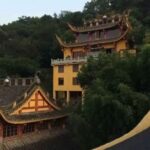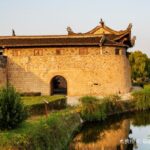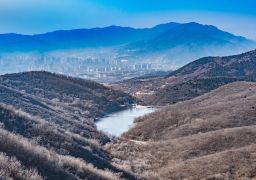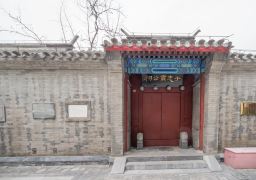Wuxie Chan Temple is located in the core area of Wuxie Scenic Area in Zhuji, Zhejiang Province, only two or three hundred meters away from East Dragon Pool. In the Tang, Song, Ming and Qing dynasties, Wuxie Chan Temple had prosperous incense and was one of the famous ancient temples in Yuezhong. It is now a Buddhist activity place approved by the Zhuji Municipal People’s Government. The Buddha statues in the temple were officially consecrated on March 16th of the lunar calendar in 1995.
The unique forest landscape of Wuxie Mountain and the unparalleled Wuxie Waterfall attracted people’s attention a thousand years ago. In the third year of Yuanhe in the Tang Dynasty (808 AD), the eminent monk Lingmo of Mount Wutai traveled in the south of the Yangtze River. He was attracted by the strange scenery of ‘heaven makes a brocade screen surrounding ten miles’ here. ‘Green bamboos are rippling and seem to cover the sky. One can practice meditation under Qizhen Rock.’ The Buddhist master then chose this feng shui treasure land, carried earth and built stones, cut down trees and built thatched huts, and built a meditation courtyard. And he recruited many disciples to spread Buddhism. Wuxie Chan Temple has experienced prosperity and decline. It was once expanded to thirty-six houses, including mountain gates, Heavenly King Hall, Mahavira Hall, rear main hall, Sutra Depository, Buddha Tower, official hall and wing rooms, etc. The total number is no less than a hundred, and the incense is extremely prosperous. Wuxie Chan Temple is backed by Qizhen Rock, facing the five-level waterfall in the northwest. In front of it is the front courtyard of the temple. The gurgling stream flows around the courtyard and leaves. The surrounding peaks undulate. The towering silver trees are set off by green bamboos. Song Liao Yubi’s poem says: ‘The secluded temple is deeply locked by green moss, so an eminent person is sent here to stay. The wind turns over the elephant palace and the sound of pine trees is broken. After the rain passes, the bamboo in the meditation room is green and floating.’ On the front courtyard of the temple, there are two inconspicuous rocks, small and exquisite. One is like a green lion sitting down, and the other is like a white elephant squatting. Legend has it that Master Lingmo must come here to breathe and chant sutras in the morning. The sound is beautiful. The lion and elephant are enlightened by the true meaning and turn into stones by sitting. Later, Liangjia often sat on this stone to chant sutras. It is extremely spiritual. Beside the two stones of lion and elephant, there is a towering ginkgo tree about 30 meters high and 1.2 meters in diameter. It is ancient, vigorous and majestic. It stands like a pillar supporting the sky. Its branches and leaves expand layer by layer to the surroundings and spread widely like a parasol. It was planted by hand when Lingmo built the meditation courtyard. It has a history of more than 1100 years. In the atrium of the temple, there are two magnolia trees with gnarled branches and lush leaves, one is white magnolia and the other is purple magnolia. After the Spring Festival, the white magnolia is in bud. The pure white, large and thick-petaled flower buds are like goose eggs hanging upside down. In early March, silver flowers are in full bloom, like hundreds of jade bells hanging upside down, gently singing the praise of spring in the spring breeze. In late March, the petals of white magnolia quietly fall. Slowly, tender green leaves grow on the branches. At this time, the purple magnolia is hanging with budding buds blooming one after another. Soon the red flowers are in full bloom, reflecting the whole hall in red light. It is interesting to contrast with the verdant green leaves of white magnolia and takes up the Spring Festival of the world. The opening hours are from 8:00 to 16:30 all year round.Wuxie Chan Temple
Wuxie Chan Temple is located in the core area of Wuxie Scenic Area in Zhuji, Zhejiang Province, only[...]









